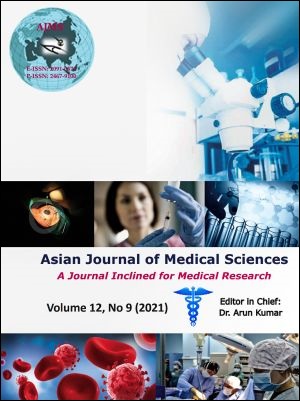Psychiatric and Medical Co-morbidities among the substance abusers presenting at Patna Medical college- A clinical study
Keywords:
Medical co-morbidities, Psychiatric co-morbidities, Substance AbuseAbstract
Background: The link between hazardous types of illegal drug use and significant public health issues is a critical issue for national and international drug policy. There are several negative health effects connected with drug use, with the avoidance of both overdose
fatalities and drug-related blood-borne diseases being of special importance. However, there has been an increasing understanding in recent decades that the existence of mental illnesses connected with drug use poses a significant barrier for public health interventions.
Aims and Objectives: • To investigate the trend of drug misuse in North Bihar Patients. • To determine the co-morbid & psychiatric medical illnesses.
Materials and Methods: It was a cross-sectional research conducted over a one-year period on 200 drug abusers from North Bihar and presenting at Patna Medical College in the Indian state of Bihar. Individuals from the sample were separated into two groups based on their age (<25 Years & >25 years) and gender. The pattern of drug abuse, as well as the mental and medical co-morbidities that were linked with it, were investigated in relation to age and gender.
Results: The sample size of the present study was 200 consisting of 183 males and 17 females. The total sample was analyzed separately with respect to age and sex. There were 55 patients below 25 years and 128 patients’ ≥ 25 years. The study found that 91.5% of substance abusers were males. Among the males, 48.6% were abusing alcohol and 19.1% were abusing polysubstance. 18.6% were intravenous drug abusers and 8.2% showed high risk behavior. Among the females, 29.4% of the female patients were abusing alcohol. The percentage of women abusing poly-substance was 35.3% and poly-substance and alcohol was 17.6%. The number of female patients involved in high-risk behavior was only 11.8%. Intravenous drug abuse and high-risk behavior was commoner in age group < 25 years than in the age group of >25 years. 17.5% received a psychiatric co-morbid diagnosis and 38.5% received a medical co-morbid diagnosis. The prevalence of schizophrenia and depression among male patients with mental co-morbidity was 63.3 % (n=19), with depression accounting for 6.7 % (n=2). On the other hand, only five female patients, were found to have mental co-morbidity.
Conclusion: The large number of young individuals taking intravenous drugs in north Bihar reflects the high level of human-to-human contact with bordering North-Eastern states and Nepal. The situation is critical, and immediate action is required.
Downloads
Downloads
Published
How to Cite
Issue
Section
License
Copyright (c) 2021 Asian Journal of Medical Sciences

This work is licensed under a Creative Commons Attribution-NonCommercial 4.0 International License.
Authors who publish with this journal agree to the following terms:
- The journal holds copyright and publishes the work under a Creative Commons CC-BY-NC license that permits use, distribution and reprduction in any medium, provided the original work is properly cited and is not used for commercial purposes. The journal should be recognised as the original publisher of this work.
- Authors are able to enter into separate, additional contractual arrangements for the non-exclusive distribution of the journal's published version of the work (e.g., post it to an institutional repository or publish it in a book), with an acknowledgement of its initial publication in this journal.
- Authors are permitted and encouraged to post their work online (e.g., in institutional repositories or on their website) prior to and during the submission process, as it can lead to productive exchanges, as well as earlier and greater citation of published work (See The Effect of Open Access).




